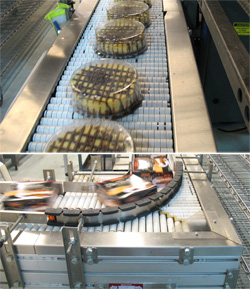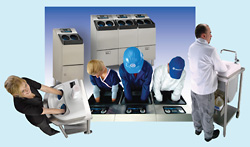
Corn for ethanol increases food prices
In 2008, 30-35 percent of corn production was planned to be diverted for ethanol production. In 2008, a bipartisan letter, cosigned with 58 House members, was sent to the Administrator of the EPA calling for the promotion of advanced biofuels that do not contribute to food price inflation or create new environmental concerns.
“Today, nearly 40 percent of
“We urge Congress to freeze the amount of corn ethanol that must be blended into gasoline to provide advanced fuels more time to reach commercial scale,” says Faber. In addition, Congress should immediately end the Volumetric Ethanol Excise Tax Credit (VEETC) and instead invest in advanced fuels. “Congress should reject proposals to redirect VEETC to corn ethanol infrastructure and instead invest in advanced fuels that do not pit our energy security needs against our food security needs,” adds Faber.
According to Geoff Moody, GMA director, energy and environment policy, the ethanol industry is mature and is exporting ethanol to the Middle East and
According to Moody, the current cost of corn is hovering around $8 per bushel, and depending on any weather issues that could deleteriously affect crops this year, the cost of corn could be quite volatile with both low stocks and nervous commodities investors.
For more information, visit GMA online.
Packaging: Convenience or green?
The report also explores innovation in food and beverage packaging across a number of information sources including patents, trademarks, scientific literature and litigation data. It found the presence of an environmentally friendly “loophole” when it comes to calling a package “green.” While patents mention biodegradability, recycling and barrier films, a lack of standardization in what constitutes an environmentally friendly package has resulted in ambiguity within the industry. The US Federal Trade Commission, US Sustainable Packaging Coalition and European Organization of Packaging and the Environment are working on setting these standards.
The report shows convenience is not just an indulgence; it reduces food waste, aids in portion control and serves the elderly. An example of the play between convenience and environmental consciousness was Frito Lay’s 2010 introduction of its biodegradable Sun Chips bag, which was taken off the market, mostly because of consumer complaints about the noise generated when flexing the container.
For more information and/or to download the study, visit the Thompson Reuters website or contact Laura Gaze, 203-868-3340.
Danger: Potential of tipping pallets
“The RMI specification, which the International Building Code (IBC) references for the design of steel storage rack, must be met, or permitting can be delayed-but not everyone may know about it,” says Anne Russell, senior structural engineer at Steel King, a designer and manufacturer of warehouse storage rack, pallet rack and material handling products. “This is particularly common when dealing in used rack or smaller warehouse operations. The risk of rack tipping increases where fork trucks operate or when racks are loaded improperly.”
As a prime example, Russell points to American National Standards Institute (ANSI) code MH-16.1 2008, which is the RMI specification for the design, testing and utilization of industrial steel storage racks.
“If a vendor is RMI-compliant or offers a calculation package for the permit process, the rack is automatically designed to spec,” says Russell. “But that’s not always the case.”
While avoiding the overloading at the top of pallet racks and installing more robust base plates can help to minimize the risk of a pallet rack tipping, it’s not always enough.
For warehouse owners and managers who may be uncertain whether their pallet rack or storage rack meets RMI specs for height-to-depth rack ratio in low seismic areas-which may put them at risk of a pallet rack tipping-Russell offers some guidelines.
When taking into account the height-to-depth ratio of the rack, the height would be the dimension to the top-loaded shelf level and not necessarily the height of the upright, unless the top-loaded beam level is at the top of the rack. For instance, if the upright height is 300 inches, but the top-loaded shelf level is 284 inches, and the upright depth is 48 inches, the height-to-depth ratio would be 284/48 (5.9:1). This is acceptable (less than 6:1 as specified in the RMI code) so no special action may be required.
However, if the height-to-depth ratio is between 6:1 and 8:1, either oversized base plates or the use of row spacers in back-to-back configurations will be needed. If any selective pallet rack in low seismic areas has a height-to-depth rack ratio greater than 8:1, it will more than likely require row spacers or cross-aisle ties.
“Whether redoing warehouse rack design or putting in new rack, warehouse owners and managers want to be certain they aren’t being penny wise and pound foolish by neglecting some important but not always well-known codes,” says Russell. “Meeting RMI storage rack specs for height-to-depth rack ratio in low seismic areas is one instance that can help prevent pallet rack damage and tipping safety hazards. For these and other important guidelines, it’s important to work with a trusted RMI-certified vendor.”
For more info, contact Donald Heemstra at Steel King, 800-826-0203.Automation News

Automated, frozen cheesecake packaging line is fast, but gentle
The processor’s main focus is in the private-label retail segment, which accounts for 80 percent of its business. The company delivers a full line of in-plant, contract manufacturing services ranging from product development to manufacturing to packaging.
Having recently expanded its production space from 18,000 sq. ft. to a 53,000-sq.-ft. plant, the company’s cheesecake making operation is new from the ground up. The facility has the capacity to produce, freeze and ship 150,000 pounds of the dessert each week-30,000 cheesecakes each day.
To sustain this throughput, Culinary Art’s added new production equipment, including five new mixers with 1,300-, 800- and 400-lb. capacity; eight new filling machines to improve filling line versatility, handling everything from dry crumb filler to piston fillers; new baking ovens; three new freezers-a -30°F blast freezer for freezing the cakes after baking, a 0°F holding freezer and another 0°F, 40-foot-high, 200-pallet freezer for holding finished product. Expanded cooler capability was also put into the raw materials storage area.
Handling cheesecakes requires a delicate touch to prevent marring the cakes. Nowhere in the production process is the handling of the product more critical than in the end-of-line packaging, and particularly in the conveying of the cheesecakes through the packaging cycle. Yet many systems that handle such delicate desserts run a high defect rate resulting in damaged products, lessened throughput and increased production costs.
“When we planned the move to our new building, we redesigned the entire production process,” says Art Keller, vice president of operations for Culinary Art’s Specialties. “We started from scratch and designed a facility that was cut out to do exactly what we wanted it to do-manufacture the world’s best cheesecakes with a very high level of throughput efficiency without sacrificing product quality.”
“Our prior packaging lines were largely manual,” says Keller. “We manipulated the cheesecakes by hand. One of the challenges we needed to solve with the design of the automated system was moving our cheesecakes through the packaging line before they are shrink-wrapped without having them touch anything, as this would mar the product. Additionally, we wanted to minimize the amount of cheesecake residue deposited on the conveying system for food safety reasons. We looked at a number of conveyor systems, but they permitted too much contact with the cheesecakes. It was a huge issue for us.”
Culinary Art’s brought in Shrink Packaging Systems to handle the integration of the shrink-wrapper and Shuttleworth to engineer a solution to the conveyor handling of the product and set up the cheesecakes for induction into the shrink-wrapper.
“We needed the conveyor to automatically center the product for infeed into the shrink-wrapper,” says Charlie Meyer with Shrink Packaging Systems. “And we needed to generate as little backpressure as possible to not only protect the cheesecakes from banging into each other, but to properly set up the cakes for induction into the wrapper. The spacing had to be very precise, a tolerance of 0.25-0.5 inch. Shuttleworth had the conveyor technology to accomplish these needs.”
The shrink-wrapper used on this line is an automatic, horizontal, continuous-motion side sealer rated at a maximum 100 cycles per minute. Shuttleworth engineered two different solutions. First, to keep the product from touching the sides along the 16-foot stretch of conveyor prior to entering into the shrink-wrap unit, and to center the cheesecakes, it designed a sequential series of different-height rollers that form a type of funnel into the middle of the conveyor.
Second, the conveyors are also equipped with Slip-Torque technology, which minimizes cheesecake damage by creating extremely low back-pressure accumulation. Low line pressure throughout the continuous-motion accumulation conveyors allows for precise product placement throughout the line and into the shrink-wrapper.
The all-stainless steel conveyors can continue to take product flow from the upstream line for a period of time instead of stopping. A low-pressure accumulation buffer absorbs irregularities in the production flow, and provides a smooth, even flow on the line, which minimizes the cheesecakes from bumping into each other.
When the cheesecakes leave the shrink-wrapper, they are placed into cartons. The conveyor runs parallel to the cartoner and is synchronized with it. As a cheesecake passes on the conveyor in front of a worker, the cartoner presents an open carton and the worker manually slides it into the carton. The conveyor/product and carton are precisely sequenced.
The conveyor then rotates the cartons and indexes them into a printer that stamps a date code on the cartons as they pass the printer.
“Shuttleworth designed this part of the conveyor with tightly spaced rollers so we get a perfectly smooth motion as the boxes go by the print head,” continues Keller. “The resulting code is very legible. With our prior system, we were having difficulty with blurring of the printed codes because of vibration as the cartons were passing.”
A 40-foot section of conveyor then routes the cartons to a case packing machine, where again, the low back-pressure accumulation system of Slip-Torque is used to stage the cartons for induction into the case packer.
The conveying capability has enabled the company to automate and streamline its entire packaging line. While improving on the product quality it had with its manual processes, it has been able to transfer this product integrity to its automated system.
“The packaging line automation has reduced our product defects to less than one-tenth of one percent, while increasing our throughput,” Keller explains. “This significantly surpasses what we could do on a manual level. With the success of this line we are now building-out a second automated packaging line to further streamline our cheesecake production.”
For more information, contact Linda Grush, 260-359-7844 or visit Shuttleworth’s website.
National robotics design contest challenges high school students
The Industrial Design Award celebrates form and function in an efficiently designed machine that effectively achieves the game challenge. It is given to the team that best presents and understands the design of their robot, regardless of whether the team wins the grand prize.
The B’East team was mentored and co-sponsored by robotics professionals from ABB’s
This year’s challenge was to complete a single task: design a robot to gather inflated rings and place them on pegs at various heights, ranging up to nine feet, then raise the robot itself to 11 feet-a foot higher than a basketball hoop. The task presented a formidable design challenge.
The entire program closely parallels a real-life engineering business, says Rick Hepperla, who is leading the integration of ABB and Baldor. “All teams across the country met at the same date and time to receive and read the specification. They were given parameters-weights and sizes of equipment, what tasks the equipment needs to achieve to score points. And then, the team had to decide what they wanted to excel at-what the trade-offs were to score points. All teams were on the same timeline-six weeks-in which to create their robot and turn it in for testing.”
“The students are required to brainstorm, design, fabricate, program and test the robot,” says Tim Obermann, ABB medium voltage drives electrical engineer and first-time mentor. “The mentors and captains encourage critical thinking and explore the choices the students have made,” he adds.
From conception to final assembly, 1000 man-hours were put into this year’s design. Students met after school and on weekends to create the final robot. “It becomes a family,” says Obermann. “Students come when they can, work together and create something that they can take pride in.”
sercos international to Intensify Cooperation with ODVA
“CIP Safety on sercos is an excellent example of how technologies from different organizations can successfully complement each other-to benefit manufacturers as well as users. Together with ODVA, we would like to discover similar synergies in other areas,” says Peter Lutz, managing director of sercos international.
Technological convergence is an important factor in achieving enhanced continuity and optimum compatibility. sercos international sees potential in areas such as control networking, connections to MES/ERP systems and the use of common profiles, especially in networked machines and systems. sercos’ open and manufacturer-independent architecture enables integration with other technologies or the coexistence with internal technologies without any negative impact on the performance and real-time properties of the bus interface, as was clearly demonstrated in the use of CIP Safety.Food Safety News

Produce supplier successfully combines food quality, safety and environmental innovation
Mastronardi Produce began as a greenhouse operation in the 1940s in
The processor has its own employee staffed labs. One microbiology lab tests inbound and outbound products and packages, and a second lab specializes in shelf life, product quality and package testing. In addition to quality certifications, the company has products meeting both USDA and Canadian organic standards.
“Mastronardi Produce is committed to food safety and food quality. We have a solid team of dedicated professionals leading our food safety department and maintaining the programs that continue to keep us ahead of the game,” says Paul Mastronardi, president. “Our goal is to provide the highest level of food safety and quality, and to continuously exceed government requirements. Our mandate is to constantly be proactive.”
Innovation, according to Darden, has been responsible for several new products and packaging, traceability and environmentally related projects. In his talk, Darden described the processor’s packaged, small, sweet tomatoes that are being sold to kids as a nutritionally healthy substitute for candy. New packaging concepts produced thermal-wrapped cucumbers, plastic-packaged tomatoes and a clear, laminated, shear-resistant, resealing produce pack.
Darden claims his company is one of the first in the industry to implement traceability in 2002. “We feel it’s very important to trace back to our growers each unit package that we sell-whether it is a PLU sticker or a product label. We want to be able to know who the grower was of that particular product.”
Mastronardi’s track and trace system could be a model for other producers. “Our [track-and-trace] system was featured during the
In addition to quality, sustainability is a core value of Mastronardi. In fact, Darden described a symbiotic relationship between a fertilizer factory and a new greenhouse growing plant in

Handwashing/bootwashing systems help processors with SQF
Jel Sert, which makes freezer bars, desserts and beverages, found that Meritech’s CleanTech automated handwashers assisted them in being recommended for food safety certification. “Handwashing was a critical component of the audit, but when the auditors saw your validated systems in place and in use, there was nothing they could say,” says Simon Richards, Jel Sert plant manager.
Oregon Freeze Dry installed seven CleanTech 500EZ handwashing units. “After one year of service we have found them to be very reliable,” says Marsha Swanson,
The most common cause of illness is attributed to poor hand hygiene. CleanTech systems ensure thorough handwashing while preventing transmission of infection. The automated handwashing system provides an invigorating massage for the hands while cleaning thoroughly and consistently, which encourages its use and thereby increases compliance. Besides killing bacteria, the automated systems use 75 percent less water compared to washing hands in the conventional way.
For more information, contact Michele Colbert, 800-932-7707 or visit www.meritech.com.